I like to sleep late. Usually, by the time I’m ready to start my day, the street below my apartment is bustling with the sounds of shop owners sweeping, the chatter of men sitting in the shade throwing tavla dice, and the constant tinkling of spoons in tea glasses. When I’m away from Istanbul it is the music from stirred glasses of çay that I miss – more than the call to prayer or the barrage of taxi horns.
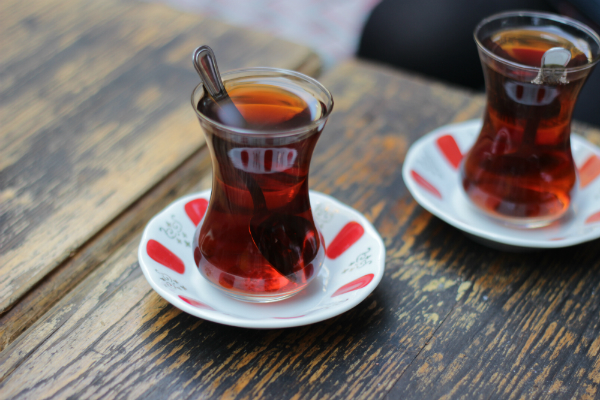
According to The Atlantic, Turkish people drink more tea per capita than any other country in the world – consuming over three kilos a year, while other reports put the figure closer to seven kilos. Needless to say, Turkish people love their çay.
Luckily, I’m a tea drinker myself. Unlike the Turks, I prefer it when it’s cold, but drink it when it’s boiling hot just the same. I drink it when I wake up and before I go to bed. I’ll drink it steaming hot as I sweat in the sunshine. Çay is woven into the fabric of Turkish life so much so that the tulip shaped glass is used as a measuring vessel in cooking and baking.
—
Turkey wasn’t always a tea-drinking culture. Turkish coffee was the dominant hot drink of the Ottoman era, but after World War I, when coffee prices soared, tea rose in stature. In 1924, a law was passed declaring Rize, located on the Eastern coast of the Black Sea, would be a major producer of domestic tea plants.
The tea grown in Rize is a black tea that when brewed is ruby red in color and is served in a tulip shaped glass. It is often steeped in a çaydanlık – two pots, one on top of the other, with the upper holding a potent tea and the bottom holding boiling water. The water is mixed with the tea; how strong you like your tea determines the exact amount of dilution. Tea is always served with sugar, but never with milk.
Teahouses are abundant in Istanbul. Oftentimes, you won’t even notice they are there: the only sign will be an opened door in the side of a shabby building. Inside, there is a man mixing tea for the neighborhood workers and the men parked on the stools that line the wall outside. These are very often all-male establishments and although there is no signage to denote this fraternal club, it’s known.
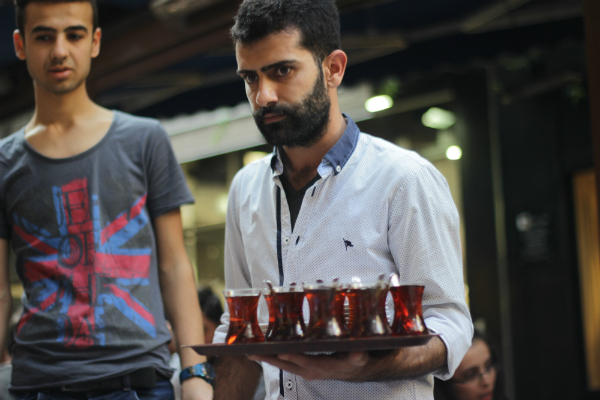
While the majority of the teahouses you see around town are men’s clubs, tea itself is the most democratic of all Turkish beverages. Everyone drinks tea – the rich, the poor, and the President. It’s almost always made and served in the same way. It’s as reliable as Turkish hospitality, which suggests three cups of çay for a visitor to your shop, office or home.
The teahouses and gardens of Istanbul are an instrumental part of Turkish life; they are an answer to the Western saloon or Italian piazza – a place where friends and families gather to share news and gossip, reminisce, argue and enjoy each other’s company. Since summer is finally upon us, I spent the week seeking out different tea gardens throughout the city. Each of them offers a unique perspective on the city (the views! oh the views!) and slight menu variations, but all of them served tea that steamed on a 28-degree day.
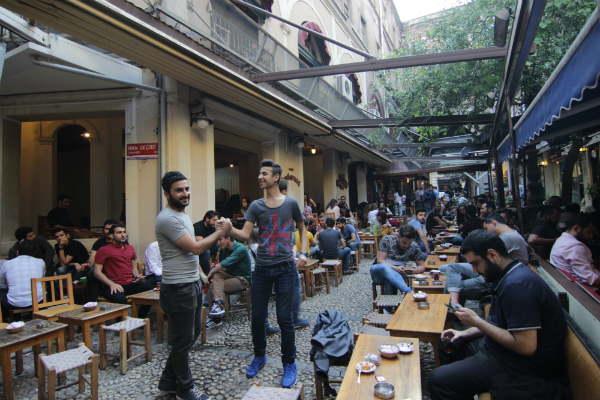
The Hazzopulo Pasajı is located in the heart of Beyoğlu, near Galatasaray Lisesi. The non-descript entrance to this shopping center leads through a passage of Ottoman knick-knacks, souvenirs and antiques shops before opening into a collection of teahouses. By my count there were four teashops, one nearly stacked on top of the other, and each offering a slightly different menu, but all centering on the large trays of tea being served.
The passage is bustling with people meeting to sit beneath the ivy canopy and amidst the paint-peeled buildings. It seemed like everyone – young and old – was taking a selfie and drinking tea. In addition to Turkish tea and coffee, many of the shops offered nargile, and the scent lay heavy in the air. While many describe the pasajı as a nice break from the crowded Istiklal, I found it just as lively as Istanbul’s main thoroughfare.
—
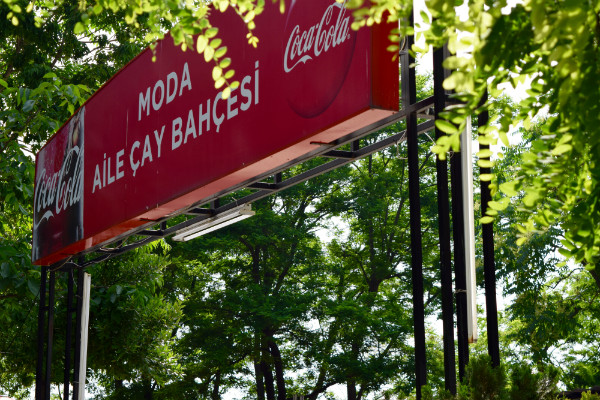
If you are looking to get some fresh air, head to Moda Aile Çay Bahçesi. The tea garden is perched above a path for cyclists and pedestrians that hugs the Marmara shoreline. On top of the hill, stretching the length of a football pitch, the garden is dotted with large umbrellas; on busy days people jockey for the tables nearest to the edge, which offer a view of the Marmara as far as the eye can see. With your back to the street, the hustle and bustle of Istanbul gives way to the hum of the ferries running passengers to the Princes Islands, which cut out from the water on a clear day, and are otherwise shrouded in a light mist of humidity.
The garden is a place to read, write, and sip tea with friends. The waiters, dressed in matching shirts and fanny packs, circle the garden with trays and call out “Çay!” The menu also offers Turkish coffee and cold beverages. If ever the city seems too big and too loud, the Moda Aile Çay Bahçesi is the place to lose yourself to the clinking of tea glasses and the chattering of friends.
—
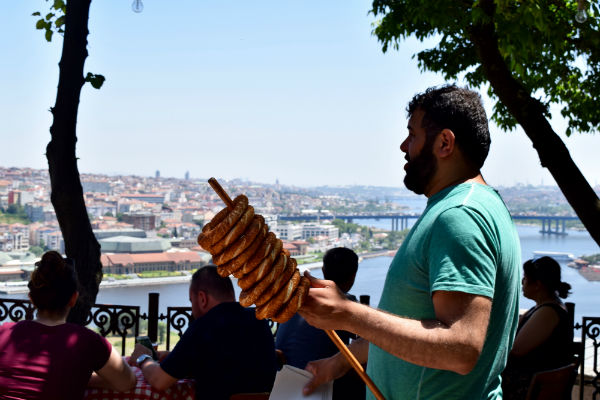
Pierre Loti Kahvehanesi, located in historic Eyüp, sits on large hill adjacent to a Muslim cemetery. The tea garden, named after the pseudonym of regular patron and French novelist Louis Marie-Julien Viaud, offers a unique view of the city, with the main sites of the Golden Horn far off in the distance and Istanbul seeming to stretch endlessly in every direction. Much like Moda, people flock to Pierre Loti for the view, and there seems to be a continuous wave of people moving from the back of the garden to the ledge to get the best selfie.
I picked one of the few tables still open, against a stone wall and away from the edge. Midway through my first tea, two couples asked to sit with me, seeing that I had ample seats available. They shared their fruit-and-nut loaf, and bought me a cup of çay. They were friendly, wishing me well before running off to catch a table near the ledge. Not a minute later, I felt a hand on my shoulder and an “excuse me” in a thick Turkish accent. The man at the table next to me had overheard my conversation. He asked about what I knew about tea and Turkey, and made sure to remind me, multiple times, that Turkish tea comes from the Black Sea. He showed me pictures of his children and taught me Turkish words like ayakkabı, gözlük, and dondurma. Before he left, he thanked me for talking to him and said he looked forward to seeing me again.
—
Do you have a favorite tea garden? Let us know in the comments – we’d love to hear from you!
// Photos by Svetlana Nekrasova and Cameron Loftus //









